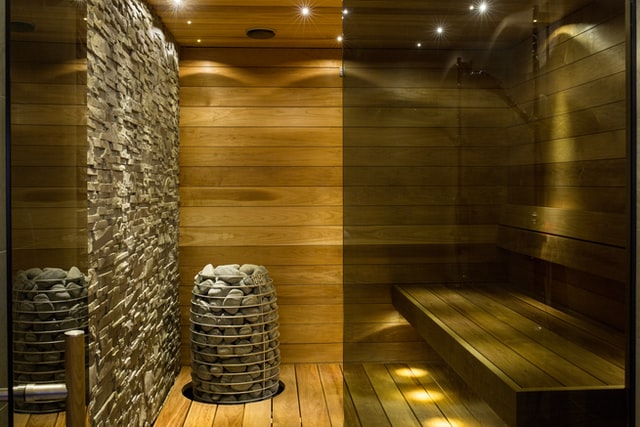Among other genius innovations like heart rate monitors and texting (yes, texting), we can thank Finland for the invention of the sauna. That’s right, Finnish brilliance brought us the sauna, invented thousands of years ago and still in use throughout the world for relaxation and, increasingly, health benefits.
It’s common knowledge that sweating helps rid your body of unhealthy toxins, clarifying your internal systems and skin. New research is continuously being done that shows us just how myriad the benefits of regular sauna use can be. This article will walk through those benefits and discuss how you can incorporate a home sauna routine into your healthy lifestyle (and get ultra-relaxed while you do).
Oh, The Benefits of Home Saunas For…
Beauty

Saunas are great for your skin. Regular sauna sessions help rejuvenate and cleanse the skin, keeping it healthy, glowy, and moisturized. The sauna’s heat raises your circulation, helping to increase blood flow and give you that rosy-cheeked glow. Additionally, the moisture from the steam helps shed dead skin cells, promoting the growth of new, fresh skin cells. Sweating (an inevitable part of a good sauna) flushes toxins and excess buildup out of your pores, helping to clarify your complexion and prevent breakouts and acne.
Who doesn’t love passively burning extra calories? The sauna’s heat causes your heart to work a little harder, meaning that you burn more calories sitting in the sauna relaxing than you would on your couch. Don’t take this too far, though. The safe time limit in a sauna is 20 minutes. Don’t think of the sauna as a means of weight loss, more that it’s just an added benefit of already healthy activity.
Saunas help with collagen production. Collagen is that all-important part of our skin that helps it retain elasticity and look young. The heat of a sauna promotes collagen production, which in turn gives your skin a plump, youthful appearance. Why pay for pricey collagen products when you can boost your own natural collagen production with a home sauna? That’s a win for everyone.
Wellness

The magic of the sauna is everywhere! There are a lot of established benefits, and research is still finding more. Among the ones we’re most familiar with, a sauna can often help:
Improve breathing. Regular sauna sessions can positively affect people with conditions like asthma and bronchitis. The reasons that this is the case are relatively technical, but suffice to say that sauna is good for your respiratory system. While it has been proven safe for people with respiratory conditions, check with your doctor before starting a home sauna routine.
Decrease stress. Reducing cortisol levels in the body is part of what helps us destress. The sauna is perfect for this for a few reasons. The heat helps our muscles relax, but even just the sauna environment is conducive to relaxation. Saunas are meant to be quiet places to go, specifically to relax and rejuvenate. The soft, warm air and soothing heat help those stress hormones back right off.
Boost mood. The reasons for why this happens aren’t well studied, but the results speak for themselves — regular sauna sessions increase hormones like epinephrine and dopamine. These hormones directly play important roles in improving lifestyle and preventing mood disorders. These hormones are responsible for feelings of happiness and contentment — and who couldn’t do with more of that, right?
Detoxify. Sweating is one of the best ways that your body rids itself of toxins and impurities. You absolutely get this benefit when you sweat from exercising, but it’s a different type of detox in a sauna.
Soothe muscle pain. The sauna’s heat is excellent for relaxing sore muscles and relieving tightness in the back, hips, and knees. Enhance this effect by incorporating ice bath therapy into your routine. The sauna’s heat helps muscles loosen up, while the subsequent immersion in cold water from an ice bath reduces inflammation and provides additional relief for soreness. This dual approach not only aids in muscle recovery but also alleviates a range of bodily discomforts, from headaches to various aches and pains.
Improve sleep. Improved sleep from regular sauna sessions results from a combination of all the other benefits. It’s not hard to imagine that if you’re breathing better, less stressed, happier, and in less pain, you’re probably going to sleep like a baby, too!
How to build your home sauna

Types of Saunas
You might think all saunas are the same, but there are some choices to be made before you put in your home sauna. The first and most important step is to determine the type of sauna you want:
Traditional saunas are thousands of years old, the first Finnish saunas, and have changed remarkably little to now. They use a heat source to create dry heat, combined with heated rocks that you ladle water over to generate steam in the room. They’re more humid than a dry sauna but much, much less humid than a steam room.
Dry saunas are typically cedarwood, just like a traditional sauna, but without hot rocks and steam. Some people prefer them for home use because you don’t need to worry about the humidity being vented out of your home to avoid potential mold and mildew concerns. Of course, if you’re putting your sauna outdoors, no worries either way!
Infrared saunas are the newest and least tested type of sauna. The room itself does not heat up to the same degree as traditional or dry saunas, but rather the infrared rays penetrate your body to increase your temperature. It is a more delicate process than other saunas, allowing you to stay in longer. Many spas offer infrared treatments as a different service than a traditional sauna.
Steam baths are a whole other ballgame. Whereas a Finnish sauna incorporates some humidity into the heat of a sauna, steam rooms are nearly 100% humidity. While they sometimes get included in the same category as a sauna, steam rooms are technically their own category.
Choosing the Best Location For Your Home Sauna

When choosing the location for your home sauna, a few spots tend to work best. It’s crucial to consider practicalities like your electrical outlets, support, insulation, etc.
Basement – This is very commonplace for home sauna installation for a couple of reasons. First, putting your sauna directly onto your foundation means having plenty of support for the extra weight. Second, basements tend to be quiet and tucked away from the rest of the house – perfect for relaxing.
Bathroom – If you have the space, your bathroom might be a very convenient place to install your home sauna. It should already be equipped to deal with steam and moisture, plus you keep your towels, etc., and you can easily jump into the shower post-sauna. This only works if you live alone or have another bathroom, however!
Garage – If you don’t have space inside for a sauna, your garage might be the perfect spot. Perhaps not the most picturesque of locales, you’ll forget all about it once tucked into your sauna haven.
Outdoors – Depending on your climate, the outdoors could be an excellent place for a sauna. Do some research first on the type of sauna you think would work best and what environment it’s best suited to. Not all saunas can withstand extreme temperature fluctuations.
Pre-built Saunas vs. DIY
So, you’ve decided that you want a home sauna, now what? Now you get to choose whether you want to build it yourself, put it together yourself, or go portable! Here’s the lowdown on each type:
Pre-built – A pre-build, also called a pre-fab, sauna comes to you ready to put together. Think of an IKEA sauna — all the pieces are there, you just need to follow the directions and put it together. If you shudder at that thought, you can also hire a handyman near you to do that part for you.
DIY – If you’re handy with tools or have home reno experience, you might be able to save some money by ordering just the inside of your sauna. Essentially, these kits come with the guts of your sauna and sometimes the inside wood, but the frame, exterior, and all the cutting are up to you to do.
Portable – If you’re renting or thinking that you might be moving soon, a portable sauna is a great option. This type of sauna is freestanding and just needs an electrical plug. It can also be an excellent option to test out the sauna life without committing to a built-in one right off the bat.
Pro Tips

Saunas have some incredible health benefits but also some important safety considerations. Here’s what not to do so you can keep having safe, fun, and healthy experiences in your sauna. (It’s a good idea to make a sign with these precautions and put it near your sauna if you’re expecting that you’ll have family, friends, or guests using the sauna when you’re not there.):
- Do not go in for over 20 minutes – lengthy exposure can cause heatstroke.
- Do not drink alcohol or use drugs before or during use – elevated heart rate means you’ll metabolize substances differently.
- Stay hydrated before, during, and after.
- Do not use if pregnant.
- Shower after use.
- Get out if you start feeling unwell.
Welcome to the wonderful world of home sauna life. You’re about to open the door to a whole new way of enjoying daily life while improving your health, and that’s definitely something to be happy about. Get out there and start sauna shopping!




